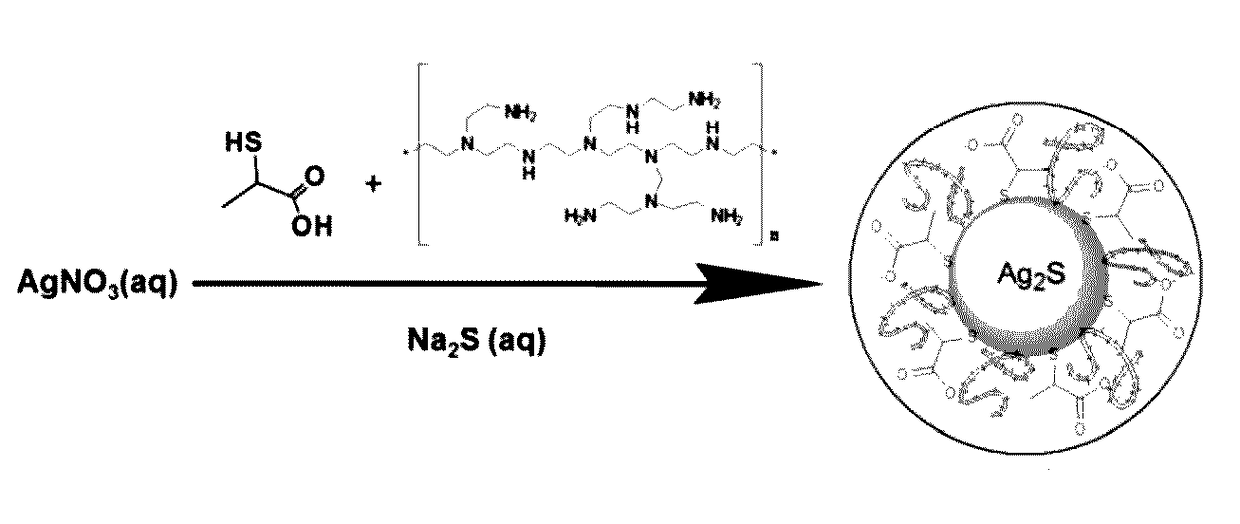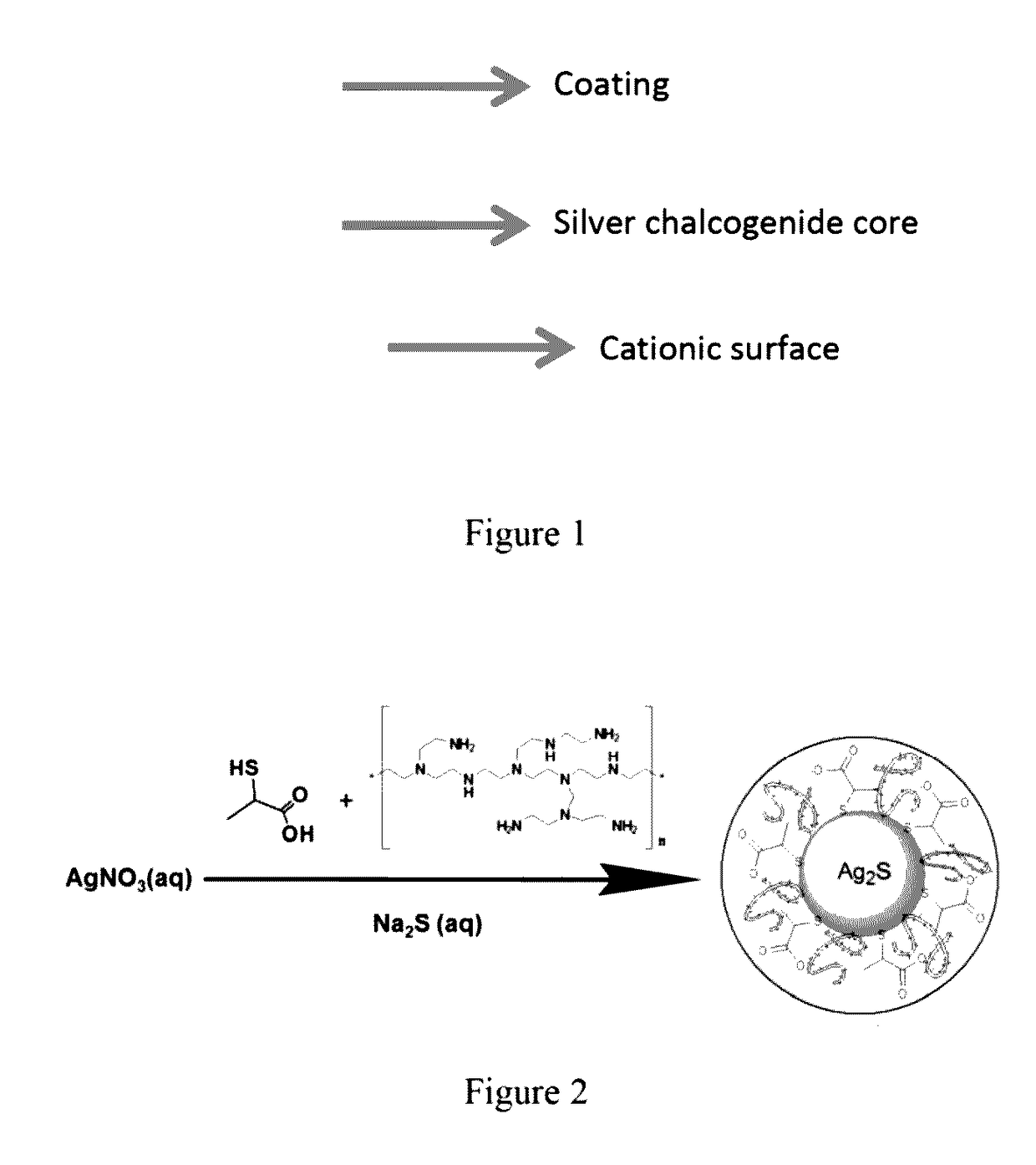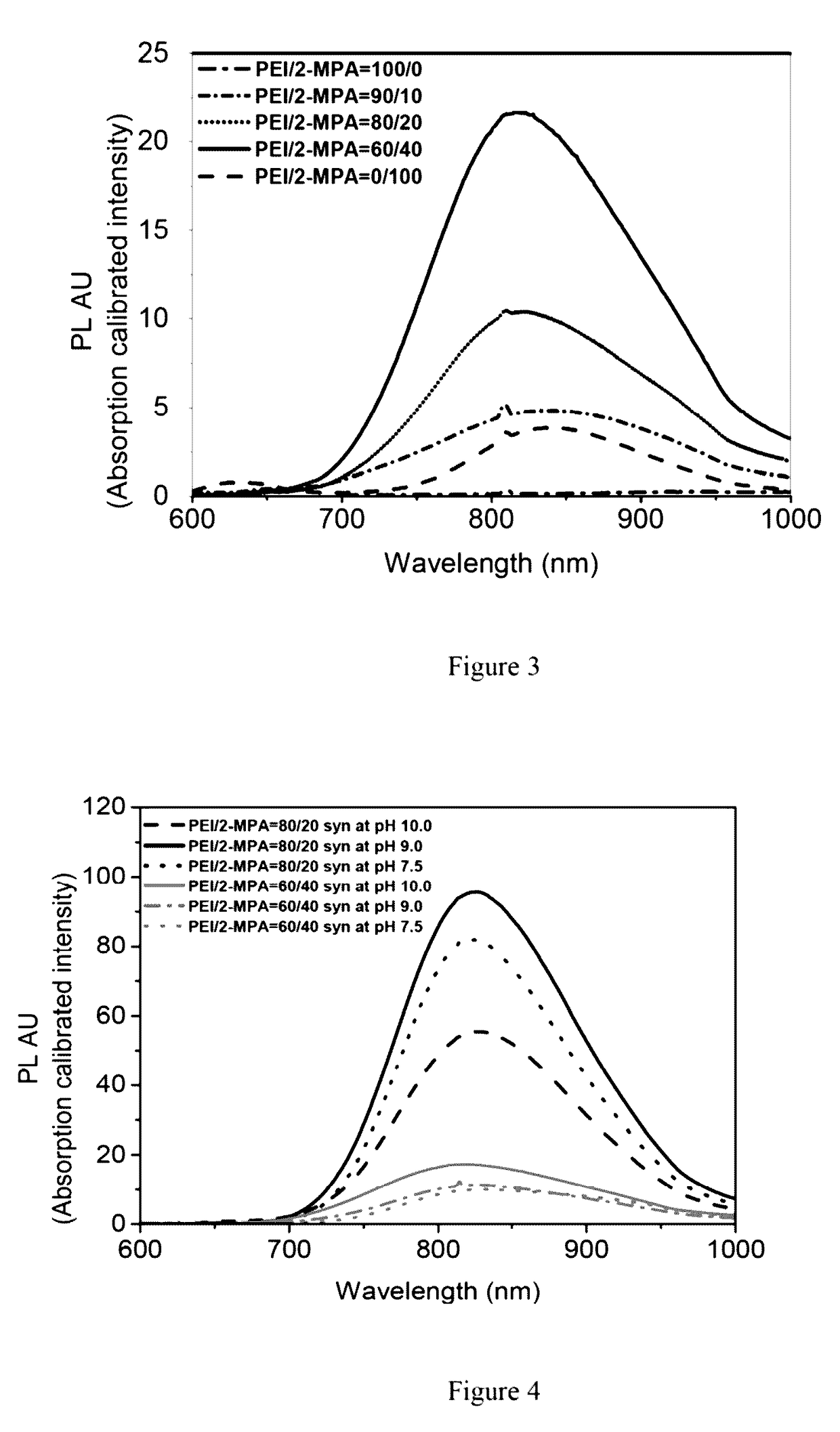Near-IR emitting cationic silver chalcogenide quantum dots
- Summary
- Abstract
- Description
- Claims
- Application Information
AI Technical Summary
Benefits of technology
Problems solved by technology
Method used
Image
Examples
example 1
[0092]General Synthesis Method and particle characterization of polyethyleneimine (PEI) / 2-mercaptopropionic acid coated Silver Sulfide (Ag2S) (Cat-Ag2S-QD) nanoparticles (as shown in FIG. 2)
[0093]All reactions were performed wider an inert atmosphere. Typically, PEI and 2-MPA were added to an aqueous solution of AgNO3 (0.25 mmol in 75 mL deoxygenated MilliQ water) and pH of the solution was adjusted to desired value using NaOH and CH3COOH solutions (2.5 M). Na2S (0.0625 mmol in 25 ml of deoxygenated water) solution was added to the PEI / 2MPA / AgNO3 solution under vigorous mechanical stirring at room temperature (25° C.) (Scheme 1.) Samples were withdrawn from the reaction mixture for the assessment of particle growth via UV-Vis spectrophotometer and spectrofluorometer. Usually, crystal growth stops in 5 min, therefore, all comparative reactions were quenched in liquid nitrogen (after 5 minute crystal growth, washed with deionized water using Amicon-Ultra centrifugal filters (30000 Da ...
example 2
[0098]Synthesis method of polyethyleneimine (PEI) / 2-mercaptopropionic acid coated silver sulfide (Ag2S) nanoparticle with 60 / 40 molar ratio of PEI / 2-mercaptopropionic acid. 2.14×10−3 mmol PEI (0.75 mmol —NH2) and 0.5 mmol 2-MPA (0.5 mmol —SH) were added to an aqueous solution of AgNO3 (0.25 mmol in 75 mL deoxygenated MilliQ water) and pH of the solution was adjusted to 10. Na2S (0.0625 mmol in 25 ml of deoxygenated water) solution was added to the PEI / 2MPA / AgNO3 solution under vigorous mechanical stirring at room temperature (25° C.) (Samples withdrawn from the reaction mixture for the assessment of particle growth via UV-Vis spectrophotometer and spectrofluorometer.) QDs washed with deionized water using Amicon-Ultra centrifugal filters (30000 Da cut off) and stored in dark at 4° C.
example 3
[0099]Synthesis method of polyethyleneimine (PEI) / 2-mercaptopropionic acid coated silver sulfide (Ag2S) nanoparticle with 80 / 20 molar ratio of PEI / 2-mercaptopropionic acid: 2.856'1.031 3 mmol PEI (1 mmol —NH2) and 0.25 mmol 2-MPA (0.25 mmol —SH) were added to an aqueous solution of AgNO3 (0.25 mmol in 75 mL deoxygenated MilliQ water) and pH of the solution was adjusted to 9. Na2S (0.0625 mmol in 25 ml of deoxygenated water) solution was added to the PEI / 2MPA / AgNO3 solution under vigorous mechanical stirring at room temperature (25° C.) (Samples withdrawn from the reaction mixture for the assessment of particle growth via Uv-vis spectrophotometer and spectrofluorometer.) QDs washed with deionized water using Amicon-Ultra centrifugal filters (30000 Da cut off) and stored in dark at 4° C.
PUM
| Property | Measurement | Unit |
|---|---|---|
| Wavelength | aaaaa | aaaaa |
| Atomic weight | aaaaa | aaaaa |
| Temperature | aaaaa | aaaaa |
Abstract
Description
Claims
Application Information
 Login to view more
Login to view more - R&D Engineer
- R&D Manager
- IP Professional
- Industry Leading Data Capabilities
- Powerful AI technology
- Patent DNA Extraction
Browse by: Latest US Patents, China's latest patents, Technical Efficacy Thesaurus, Application Domain, Technology Topic.
© 2024 PatSnap. All rights reserved.Legal|Privacy policy|Modern Slavery Act Transparency Statement|Sitemap



